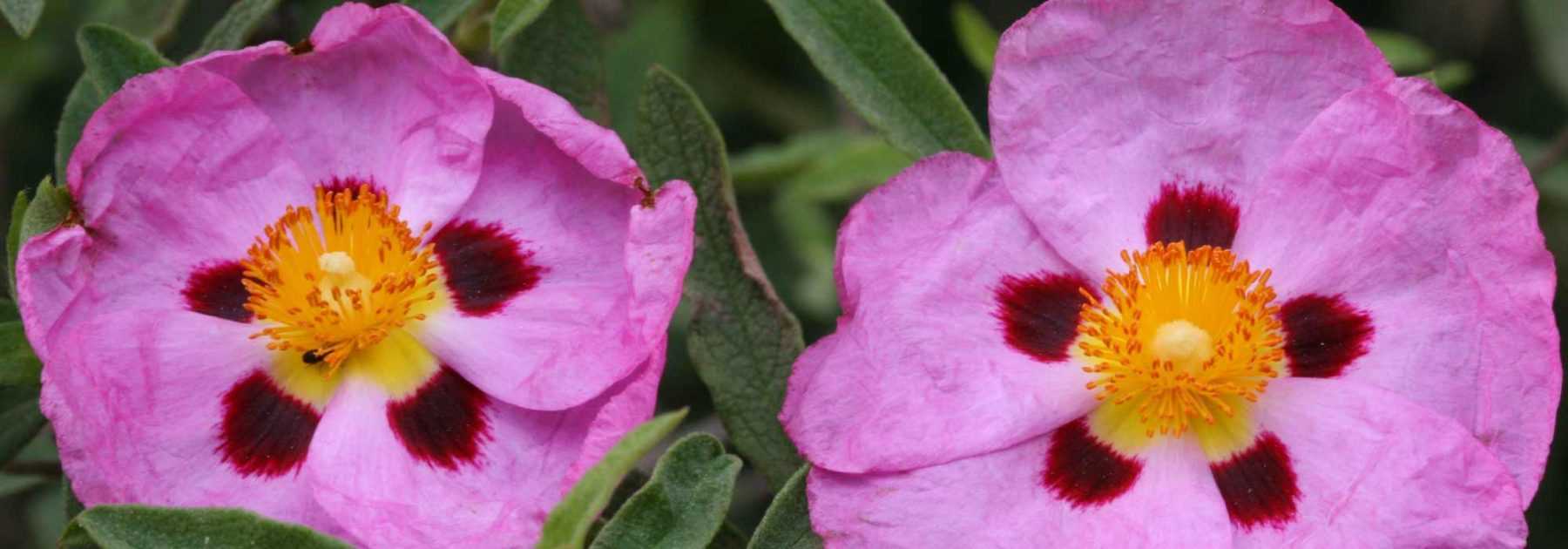
Rockrose, Cistus: Planting, Pruning and Care
Contents
The Rockrose in a Nutshell
- The Rockrose is an essential shrub for Mediterranean gardens,
- It forms an evergreen, highly floriferous bush,
- Hardy down to -10°C, it’s nevertheless best suited to mild climates,
- It thrives in full sun and only in well-drained soil,
- Once established in a sunny spot, it requires no maintenance.
Our expert's word
Have you ever heard of Rockroses? While plant enthusiasts may think of small shrubs that reign over the garrigue, for others, it evokes a treasure hunt with a map of geocaches (boxes containing hidden treasures)!
The Rockrose is a useful plant both in the garden and in herbal medicine. It is a medicinal plant renowned for the essential oil derived from the Gum Rockrose (Cistus ladanifer), traditionally used for its healing properties.
From April to July, they bring freshness to dry, water-scarce gardens with their delicate pink or white crinkled flowers.
Montpellier Rockrose, white or purple Rockrose (Cistus × purpureus)—these lively Mediterranean shrubs are perfectly adapted to drought, thriving in gardens spared from harsh frosts. Elsewhere, they can be grown in large pots and moved indoors during winter, to a conservatory or greenhouse.
Somewhat frost-sensitive but highly floriferous, they thrive in rocky gardens and arid soils where few other plants will grow.
Rockroses are rarely affected by diseases and, once established in full sun and well-drained soil, they require very little care.
Easy maintenance, planting, pruning, and propagation—here are all the secrets to growing and keeping beautiful Rockroses, these must-have garden plants!
Description and botany
Botanical data
- Latin name Cistus
- Family Cistaceae
- Common name Ciste
- Flowering avril à juillet
- Height 0,30 à 2 m
- Exposure Soleil
- Soil type Argilo-limoneux, caillouteux bien drainé
- Hardiness -10°C
Rockrose is a typical Mediterranean garrigue shrub belonging to the Cistaceae family and the Cistus genus, which includes about twenty species and numerous hybrid varieties. It grows naturally in dry, stony or rocky soils around the Mediterranean, where it roots deeply with its extensive root system. It is very common in the garrigues of southern France.
With relatively slow growth, it forms dense, bushy shrubs 0.30 to 1.50 m tall, spreading in all directions. Its bushy habit can be upright, compact or spreading. Depending on the species, it may form a regular dome (Cistus salviifolius), an erect shape (Cistus populifolius), or a very ground-hugging form (Cistus x pulverulentus).
Its lifespan is quite short, averaging around ten years.
Its flowering is enchanting! From early April to June-July, depending on the climate, the Rockrose’s foliage disappears beneath a profusion of silky flowers, with wide-open rounded corollas, either solitary or clustered in groups of two to six at the branch tips. Emerging from wrinkled buds, these rose-like flowers bloom into cup-shaped blossoms, resembling crumpled tissue paper, 2 to 10 cm in diameter, mostly white or pink.
Each flower has five petals, crinkled like tissue paper, sometimes adorned with contrasting blotches, surrounding a central pompon of golden-yellow stamens. While often white, they can take on beautiful purplish-pink hues in Cistus x purpureus or deep rose in Cistus x pulverulentus ‘Sunset’, or even creamy yellow in Cistus x revolii ‘Merrist Wood Cream’.
Each flower lasts barely a day, wilting by late afternoon and scattering petals like rain. Though short-lived, the countless buds ensure that new flowers replace them every morning throughout the blooming season. This constant renewal gives the shrub an enduring beauty for weeks.
Nectar-rich, the flowers attract bees, butterflies and other pollinators. Generally unscented (except for species like the Montpellier Rockrose), they compensate with their exceptional abundance. After flowering, brown, hairy globular seed capsules appear, retaining seeds for long periods.
Rockrose forms attractive bushy clumps with evergreen foliage, though less striking than its flowers. The persistent leaves, 1 to 10 cm long, sometimes wavy-edged and rough-textured, vary from narrow to oval or elongated depending on the variety. The foliage of Cistus populifolius, also called “Poplar-leaved Rockrose”, features large heart-shaped leaves resembling poplar leaves. The grey-green, downy leaves of Cistus salviifolius recall those of common sage.
Their strongly veined texture gives them a basket-like appearance, hence the name “Cistus”, meaning “basket” in Greek.
Young shoots are sticky and highly aromatic in hot, dry weather, releasing a penetrating amber-like fragrance on warm days.
Leaf colour varies by variety, from glossy dark green to silvery grey (Cistus albidus), including yellow or variegated forms like Cistus x corbariensis ‘Rospico’. Some have paler undersides. While deep green in summer, leaves may turn reddish-purple in winter, as seen in Corbières Rockrose.
Since antiquity, the leaves and twigs of Cistus ladanifer have yielded a resinous aromatic substance called labdanum, widely used in perfumery and aromatherapy for its medicinal properties. In the garrigue, their leaves can ignite under extreme heat due to their essential oils. Rockrose is a pyrophytic species, with germination actually encouraged by fire.
The quintessential plant of limestone scrubland, Rockrose thrives in stony, poor soils with good drainage. This exceedingly hardy shrub, resistant to drought and salty winds, loves full sun and warm, sheltered spots.
Semi-hardy, it can withstand temperatures down to -10 or -15°C in well-drained soil. North of the Loire, it’s best grown in containers and protected from frost in winter.
In the garden, it works beautifully in borders, free hedges, rockeries, dry slopes, or even on sunny terraces and balconies.
Species and main varieties
The genus Cistus includes around twenty species and many interesting hybrid varieties that vary in size (from 0.50 cm for ground-covering species to around 2 m for the tallest) and flower colour. They are typically classified into two categories: white-flowered Rockroses and pink-flowered ones.
Not all offer the same hardiness. Among the hardiest are Cistus salviifolius, the Corbières Rockrose, and Cistus x pulverulentus, which can withstand temperatures as low as -12°C, even -15°C, in well-drained soil and in a sunny, sheltered position. The Cretan Rockrose is more sensitive to frost (-8°C).
Choosing a Rockrose depends on its intended use: in borders, containers, or as ground cover.

Cistus monspeliensis - Montpelier Rockrose
- Flowering time May to July
- Height at maturity 70 cm

Cistus x purpureus - Rockrose
- Flowering time May to July
- Height at maturity 1 m
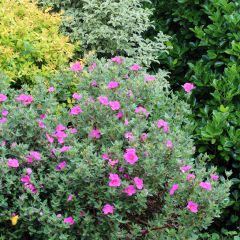
Cistus pulverulentus Sunset - Rockrose
- Flowering time July, August
- Height at maturity 50 cm

Cistus x corbariensis - Rockrose
- Flowering time May to July
- Height at maturity 70 cm

Cistus populifolius - Poplar-leaved Rockrose
- Flowering time May to July
- Height at maturity 2 m
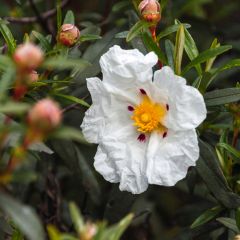
Cistus x loretii - Rockrose
- Flowering time May to July
- Height at maturity 90 cm

Cistus salviifolius - Rockrose
- Flowering time May to July
- Height at maturity 90 cm
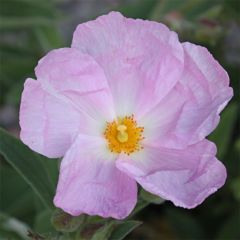
Cistus x argenteus Peggy Sammons - Rockrose
- Flowering time June, July
- Height at maturity 1,20 m
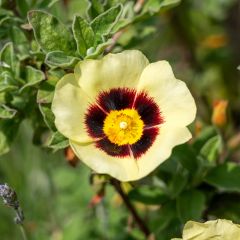
Halimiocistus wintonensis Merrist Wood Cream
- Flowering time June, July
- Height at maturity 60 cm

Cistus x corbariensis Rospico - Rockrose
- Flowering time May to July
- Height at maturity 70 cm
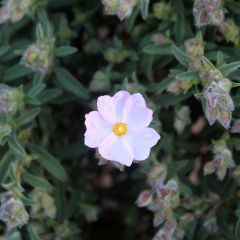
Cistus x skanbergii - Rockrose
- Flowering time May to July
- Height at maturity 60 cm
Discover other Cistus - Rockrose
Planting
Where to Plant Rockrose
The Rockrose is a typical Mediterranean garrigue shrub that thrives naturally in dry, hot climates. It therefore struggles in overly humid regions but its foliage tolerates coastal sea spray well.
Give it full sun, plenty of warmth, and shelter from strong winds. South of the Loire, it can be grown directly in the ground, though in more northern regions, container cultivation is preferable.
With moderate hardiness, it particularly fears damp frosts below -5°C to -10°C. In well-drained soil, it shows greater cold resistance. Plant it in the warmest spot of your garden, in full sun against a south-facing wall. Some woodland species like Cistus salviifolius stand out for their shade tolerance and ability to handle root competition.
It loves stony or sandy soils where water never stagnates. Above all, it detests heavy, compacted, suffocating soils where it will not survive.
Rockrose works well as a standalone specimen or in groups. It’s not overly bulky. However, due to its slow growth, avoid unnecessary transplanting to give it time to establish. Use it in borders, rockeries, or as ground cover along pathways or stairways. In regions with harsh winters, container growing is an option.
When to Plant Rockrose?
Plant Rockrose after the last frosts, in April-May north of the Loire, and September-October in hot, dry climates.
How to Plant Rockrose?
If your soil retains moisture, plant your Rockrose atop a mound where water won’t pool. For group planting, space plants 0.4 to 1m apart, depending on the variety.
- In the ground
- Dig a hole 2-3 times the pot’s volume
- Add a gravel layer at the base
- Plant level with the root collar
- Mix in coarse sand
- Backfill the hole
- Keep the shrub upright
- Gently firm the soil with your foot
- Mulch the base
- Water thoroughly at planting, then sparingly in the first year, allowing soil to dry between waterings
- Thereafter, water only during prolonged heatwaves
In containers
The substrate must be extremely well-draining to avoid waterlogging. Place in full sun in a large pot at least 50cm in diameter.
- Add a thick drainage layer (gravel or clay pebbles)
- Plant in sandy soil mix
- Mulch the base
- Water deeply but infrequently, letting the substrate dry between waterings
- In summer, water when the surface soil is dry
- In cold regions, move pots to frost-free shelter at first frost and reduce watering
→ Learn more in our guide: Planting Rockrose in Pots
Care and maintenance
The Rockrose is a low-maintenance shrub and, when well-established in perfectly drained soil, it offers better hardiness.
Perfectly adapted to sun and drought, it tolerates long periods of aridity well.
- In the ground, once established, water only during prolonged dry spells.
- Potted rockroses require more regular watering: in summer, water when the soil is dry and allow the substrate to dry out between waterings.
- In winter, if severe frost is forecast, protect your shrub with winter fleece. Mulch the base of the most frost-sensitive varieties (Cistus salvifolius) to insulate them from the cold as much as possible.
- Move potted rockroses to a frost-free location in regions where temperatures regularly drop below -10°C.
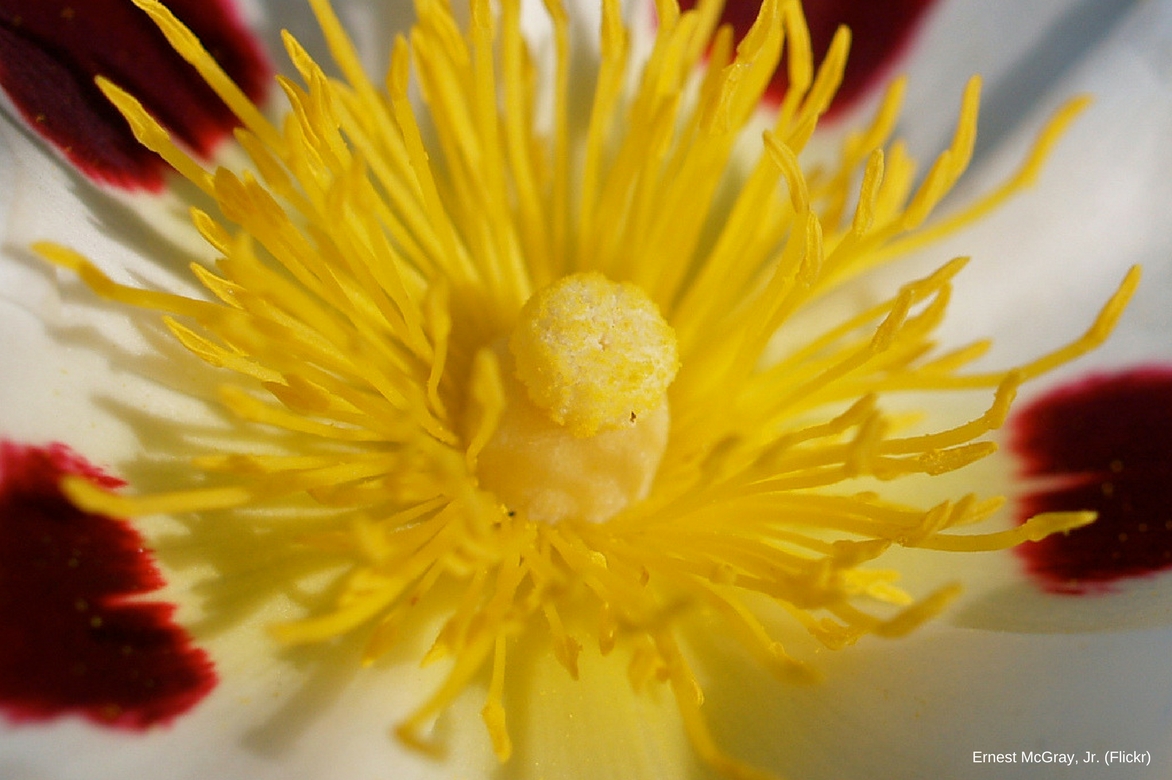
When and how to prune cistus?
Pruning Cistus is not necessary. The rockrose does not tolerate hard pruning well; it’s better to replace old, bare plants. Only intervene to remove any dead branches or to carry out very light trimming to maintain a balanced, bushy shape.
After flowering, simply cut (pinch) back the last third of the stems to encourage branching and remove dead wood.
Diseases and potential pests
Behind its delicate flowers lies a strong character and unmatched hardiness. The Rockrose is a tough plant, resistant to both diseases and pests. It fears only two things: cold and dampness.
Occasionally, it may suffer from fungal infections caused by heat combined with moisture. At its base, it can sometimes be colonised by Cytinus, a small parasitic plant with yellow flowers.
In excessively chalky soil, it may develop signs of chlorosis over time due to lime overload.
Propagation
While Rockrose can be propagated by sowing under a cold frame in autumn or spring, the quickest method is by cuttings, though this is best reserved for experienced gardeners.
- In late summer, take 10 cm long heel cuttings from non-flowering stems
- Insert them into a mix of sand and compost kept slightly moist
- Place under a warm frame
- Once rooted, transplant the cuttings into a very sandy mix
- Plant out in the ground the following spring
Discover our tips for successfully taking Rockrose cuttings and our tutorial on How to sow Rockrose?
Pair
Essential in a dry, low-water garden, the Rockrose brings colour, density and brightness to borders, flower beds, and rockeries. It works perfectly in a gravel or scree garden alongside other Mediterranean shrubs or sun-loving perennials.
In an evergreen border that evokes the scent of garrigue, surround it with lavender, santolina, creeping rosemary, a Teucrium fruticans ‘Azurea’, and aromatic perennials such as thyme and sage. To enliven the scene, pair it with helianthemums, California poppies, catmints, horehounds, and drought-tolerant euphorbias (E. Characias Black Pearl).
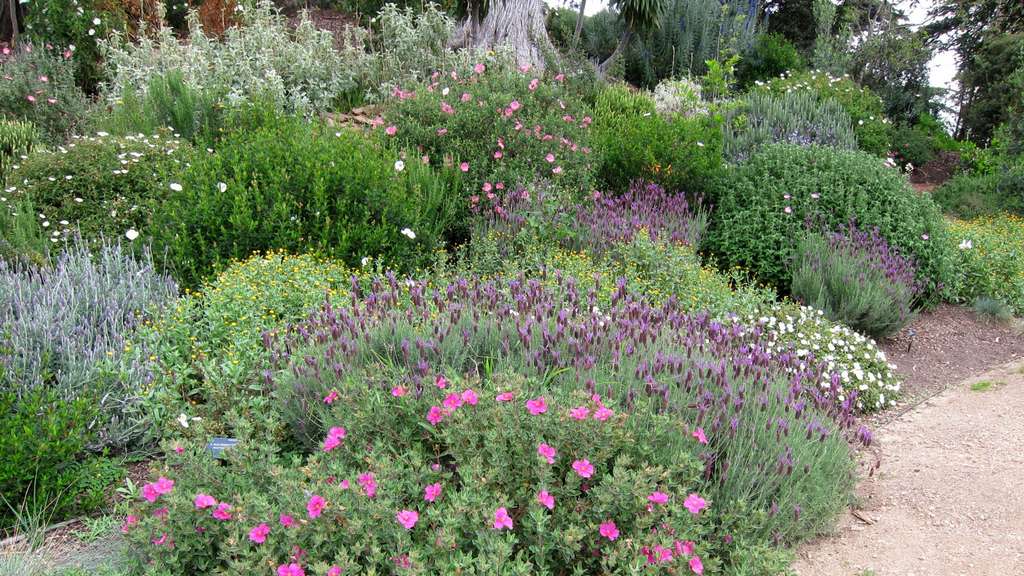

Cistus x pulverulentus ‘Sunset’, Cistus salviifolius ‘Prostratus’ and Lavandula stoechas at the San Francisco Botanical Garden on Heidelberg Hill (Cultivar413-Flickr)
The pink-flowered Rockrose pairs beautifully with the small crimson blooms of a Leptospermum scoparium. In a lush summer border, it blends harmoniously with sweet Williams, blue thistles, early-flowering gypsophilas, summer alliums, and love-in-a-mist.
The white-flowered Rockrose thrives alongside artemisias, complemented by a Ceanothus thyrsiflorus ‘Millerton Point’. It makes an ideal companion for Phlomis samia, bear’s breeches, and Geranium macrorrhizum.
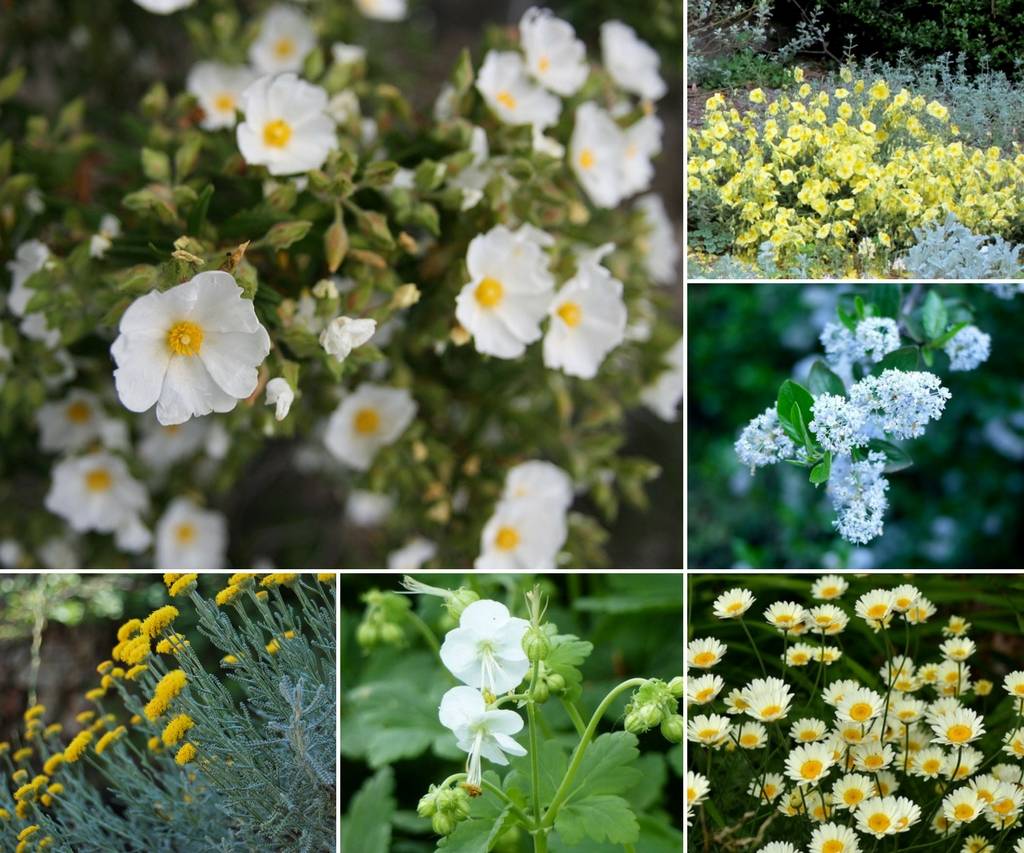

An example of a planting scheme in shades of white, yellow, and silver: Cistus monspeliensis, Helianthemum ‘Wisley Primrose’, and artemisias (Artemisia ‘Powis Castle’, ‘Silver Queen’, ‘Valérie Finnis’…), Ceanothus thyrsiflorus ‘Millerton Point’, Santolina chamaecyparissus, Geranium macrorrhizum ‘White Ness’, and Anthemis tinctoria ‘Sauce Hollandaise’.
The Rockrose will make its most striking impact in the foreground of a more exotic composition, surrounded by a Melaleuca gibbosa, a Callistemon rigidus, or a Grevillea rosmarinifolia.
Useful resources
- Dive into the heart of the Corsican maquis and discover its botanical beauties!
- Our advice sheets: Choosing a rockrose, Sowing rockroses and Pairing rockroses
- Discover other allelopathic plants!
- Our advice sheet: Planting a rockrose in a pot
- Subscribe!
- Contents




































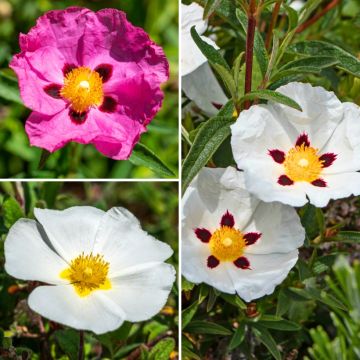
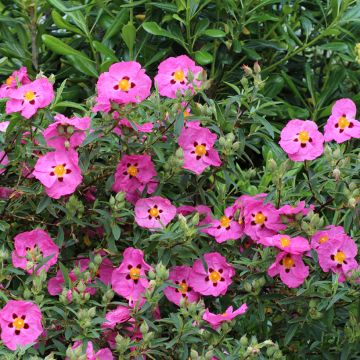

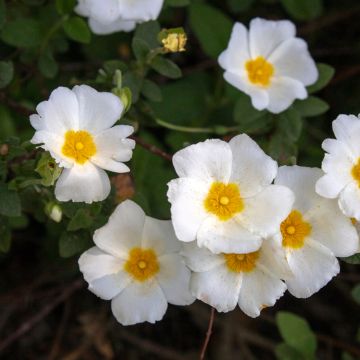
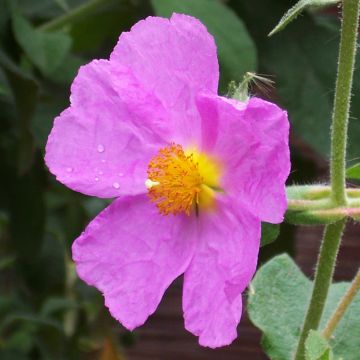
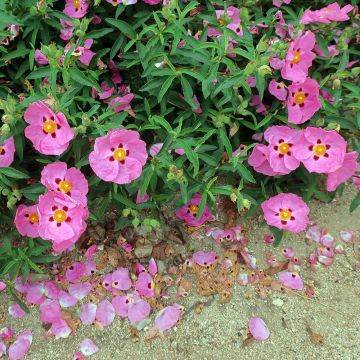


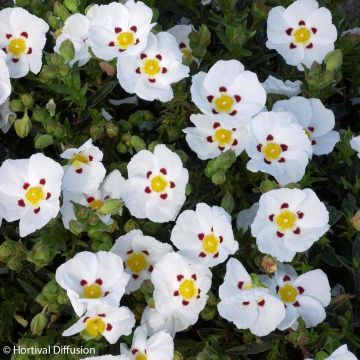



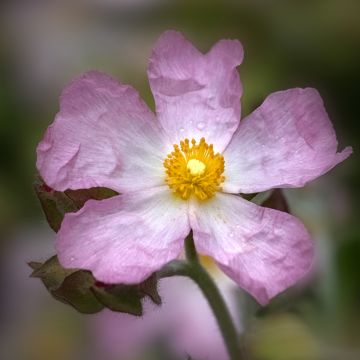
Comments